Let’s explore the differences between tennis balls and padel balls. While they share some similarities, there are distinct features that set them apart:
- Internal Pressure:
- Tennis Balls: New tennis balls typically have an internal pressure of 14 psi (pounds per square inch).
- Padel Balls: New padel balls, on the other hand, have an internal pressure of 11 psi.
- Both types of balls are made from the same materials and in the same ratio by manufacturers.
- Diameter Difference:
- Tennis Balls: A tennis ball must have a diameter between 6.54 cm and 6.86 cm.
- Padel Balls: Padel balls need to be between 6.35 cm and 6.77 cm in diameter.
- The additional diameter of a tennis ball is due to its higher pressure when new.
- Weight:
- Both tennis balls and padel balls must weigh between 56.0 grams and 59.4 grams. There is no weight difference between the two.
- Materials and Manufacturing:
- Tennis balls and padel balls are made from the same base materials, including their core and fuzzy outer layer.
- Major racket sports brands often use the same factories to produce both types of balls.
- The regulations for tournament legal tennis balls are determined by the International Tennis Federation (ITF), while the World Padel Tour (WPT) governs padel ball regulations.
- Bounce Behavior:
- Due to the higher pressure, a new tennis ball bounces about one inch higher in the official bounce test compared to a padel ball.
- However, both tennis balls and padel balls have the same stipulated minimum bounce height before being classified as flat.
- Spotting the Difference:
- It takes a trained eye to distinguish between padel and tennis balls, as they look very similar.
- Some tennis balls that fail the bounce test may end up being branded as padel balls, especially those sold as off-brand items by large sports retailers,
In summary, while tennis and padel balls share commonalities in terms of materials and manufacturing, their internal pressure, diameter, and bounce behavior set them apart. So next time you’re on the court, pay attention to the ball you’re playing with—it might be more than meets the eye!

































